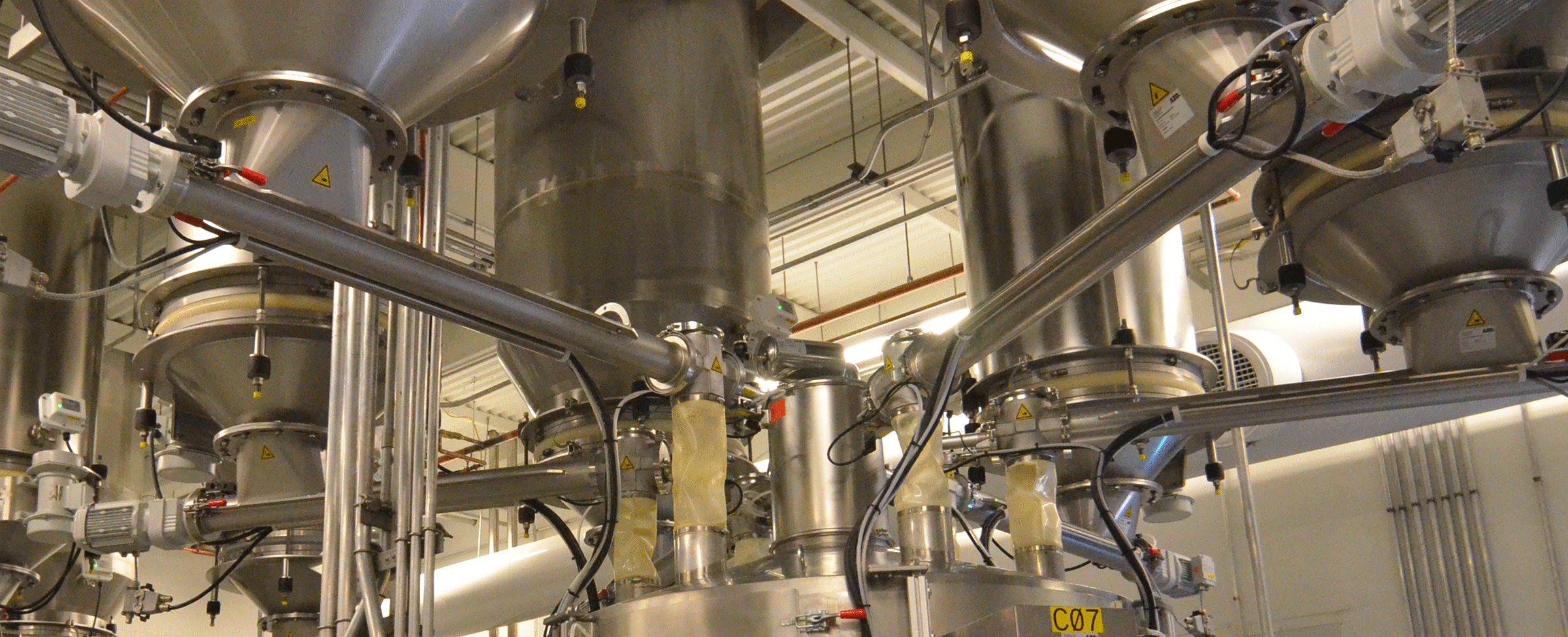
Batching Best Practices

INTRODUCTION
This intent of this paper is to present a few Best Practices I have discovered over the years that lead to an improved performance of ingredient automation (batching) systems.
LOAD CELL INSTALLATION
Site Preparation
All mounting surfaces for the base and loading plate must be level. The distance between the mounting surface of the loading plate and base must within 1/32” of the nominal height (for proper elevation of vessel). The Load Cell Assemblies in a system must be level to within +/- 0.5 degrees.
When mounting the base plate on concrete, use grout to secure the plate after leveling. A classic 4 bolt system with anchor bolts embedded in the concrete foundation with nuts above and below the sole plate are used for leveling both within the sole plate and between sole plates.
Any welding should be done prior to installation of the load cells. Proper drainage should be provided to prevent the load point assembly from standing in water.
Installation
All load cells must be on the same plane (level) within 0.5 degrees of each other (which is approximately an inch over 10 feet).
- 4-cell system
A 4-leg weighing system adds structural strength, but requires more care in the installation in order to balance the loading on four legs. The vessel can actually wobble on two of the four legs and overload the two load cells bearing the load. It is a simple process to shim the load cells at installation to balance the four legs. Plus or minus 2mV is an acceptable load sharing target. This can be accomplished by measuring the DC mV signal between each of the load sensors, plus and minus signal wires. The difference between the highest and lowest reading should be within the 2mV tolerance. - 3-cell system
Three-leg weighing systems balance like a tripod and only require minor balancing at installation. Be careful of uneven loading, however.
Precision
The precision is equal on 3 or 4 cell systems and also equal on compression or tension load cell systems. The truth to accuracy is in the care taken during system design and installation. A good design and installation takes the following into account: level footings, balanced (shimmed) load points, absence of mechanical binding, flexible piping (how flexible – too stiff a ex joint or a ex joint that is forced into a configuration can impose unacceptable loads), environmental characteristics such as wind and temperature (wind loading introduces torque which is obvious but temperature can introduce growth – roughly 0.008″ per foot per 100ºF for steel), and the content’s center of gravity within the footprint of the scale (uneven loading may exceed a single cell’s rating). There is also the matter of determining what the full scale (full rated capacity of the load cells) and what you are trying to achieve in the way of accuracy (you can’t weigh an envelope on a truck scale). There is the accuracy of the
load cells themselves and then the accuracy of the signal conditioner at a minimum. Layer on top of that any mechanical issues in terms of binding or friction or just general poor installation and then determine whether your desired accuracy is reasonably achievable. Be careful to protect your load cells from damage during installation. Damage can occur from welding activity which will likely result in a complete failure of the cell and therefore easy to find. Something more difficult to detect is an over stressed load cell where excessive weight was applied during installation. That can affect accuracy in multiple ways such as linearity, hysteresis, repeatability, ….. Take your time calibrating your load cells after all the activity has subsided and just before you are ready to put your weighing system into service. Use multiple check points both increasing and decreasing to check for linearity and hysteresis. Then do the test a few times to assure yourself that you have repeatability. There is also the matter of the increment of delivery when looking for accuracy. For example if you have a rotary feeder (airlock) that can hold a pound of material in one of its pockets you aren’t going to be able to obtain accuracy in the ounces. Don’t forget that screw feeders also surge material when running at a high speed – their delivery isn’t uniform. There are other examples, but I think the point is made.
INSTRUMENTATION
In any batching application, the volume of material in transit between the shutoff device and the actual batch container has an impact on the ability to perform fine batch adjustments. Piping best practices are also important. Some liquid flow sensors require staying flooded in order to provide a reliable feedback signal. Nearly all flow devices need to be isolated from vibration and many flow devices (liquid and gas) assume a uniform velocity profile for their approach and exit. Even though today instruments are more tolerant of poor location, it is still best to locate the instruments with some consideration of the approach and exit conditions. There are general rules for distances from flow disturbances such as elbows, valves, etc for a flow to regain that uniform velocity profile perpendicular to its direction of travel that can be referenced in various handbooks and reference manuals.
EXTERNAL DISTURBANCES
Drafty Buildings
There are a variety of things that can have an impact on accuracy and some of them appear at first to be random. An example was a batching application where the scale hopper was large enough that it extended down through a floor. There was also a separate system that was evacuating air from the building (dust collection). As it turns out the air makeup system was not of adequate size and air was being drawn into the room below the scale hopper and drafting up past the hopper. This may not seem like much, but a 15 mph breeze has a 0.109 “w.c. velocity pressure (about). To convert that 0.109” w.c. to pounds/sq ft that equals 0.567 lb/sq ft. Therefore a 15 x 15 ft hopper would have a “breeze” variation of about 127 lbs. A 20 mph “breeze” has a 0.193” w.c. which produces a variation of about 225 lbs.
Piping Practices
Certainly anything that restricts the transfer of load onto and away from the load cells is to be avoided. Even “expansion” joints can become so overextended in their installation that they don’t truly function as flexible joints. They can be called upon to make corrections for poorly run piping installations and thereby are always imposing some sort of load on the scale container.
Be aware of anything that can introduce a pressure force up against the discharge of a scale hopper. A single pressure conveying system that is serving two separate scale hoppers can introduce a load against the hopper being loaded while the pressure system is discharging a different hopper. A means to combat this unwanted false loading is to provide a pair of isolation slide gates with a flexible connection between them at the discharge of the scale hoppers and the rotary feeder attached to the lower slide gate.
Ray Bachelor, P.E.
Chairman of the Board



